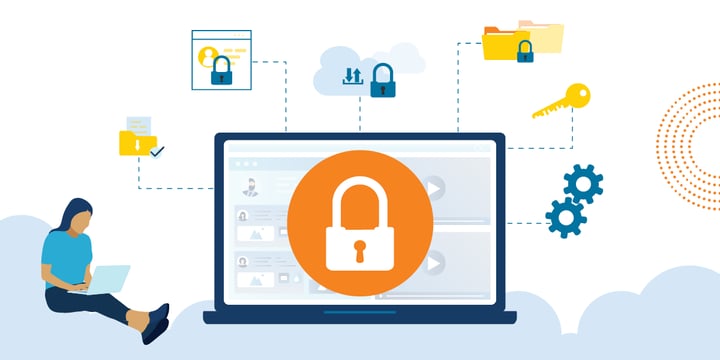Nonprofit organizations rely on data for almost every decision they make, from engaging stakeholders to designing strategies and conducting program evaluations. Data is a valuable asset, and protecting it from internal or external corruption and illegal access can shield nonprofits from financial and operational loss.

Cybercriminals look to exploit vulnerabilities in order to gain illegal access and extract, encrypt, or corrupt data. As organizations' data footprints expand, cyberthreats are becoming more sophisticated. Ransomware, destructive malware, phishing attacks, insider threats, and even honest user mistakes present ongoing and very real threats to organizations' data.
It is vital to proactively protect your nonprofit. The complexity and diversity of cyberattacks are rapidly increasing, with different types of attacks for different purposes. Although the best prevention measures might be different for each type of breach, a comprehensive security practice is the best approach for mitigating the majority of such attacks
This three-step approach can help you identify the threats, defend and protect your organization's data and operations against such attacks, and implement procedures that will help you recover in case of a breach.
1. Identify Assets and Vulnerabilities
The first step in building a comprehensive cybersecurity strategy is to identify your assets and the potential threats to those assets. Learn where assets and information are stored, who has access to them, and how critical it is to protect them. Once an organization is aware of its vulnerabilities, it can make informed decisions on handling those vulnerabilities and implementing safeguards to ensure data safety and integrity.
Cybersecurity is not just a technical challenge, but increasingly a social and behavioral one. Humans are often both the weakest link and the first line of defense in your cybersecurity strategy. Our brains are hardwired to take cognitive shortcuts to process information as fast as possible. These cognitive biases influence our decision-making processes and can be exploited by cybercriminals to manipulate our behaviors and convince us to voluntarily take an action that enables an attack.
Most breaches begin with an email containing a malicious link or attachment. The email is likely to be disguised in some way in order to appear benign. For example, it may look like an email sharing a Google document or a message from someone in your organization. The legitimacy of the email should be determined by checking the sender's email address, the context and urgency of the message, and the spelling and grammar for inconsistencies.
Implementing a cybersecurity user awareness and training program, including guidance on identifying suspicious activity and the signs of malicious attacks, is an important step in adopting comprehensive security safeguards. Organizations can achieve behavioral changes through regular data-driven security awareness training and personalized and customized coaching. Tools like KnowBe4 can be a great resource to help you train your staff on potential threats.
2. Protect and Defend
The best way to combat cyberattacks is to prevent them from happening in the first place. Limit access to sensitive assets, implement strong password policies, and use multi-factor authentication to prevent illicit access to your data. Avoid shared logins and be vigilant in deleting accounts that are no longer in use.
Use firewalls and VPNs and install and regularly update antivirus and anti-malware software on your devices. Firewalls prevent unauthorized access to your business network while VPNs create encrypted pathways for your data, allowing you to use public networks safely. Antivirus software plays a major role in protecting your system by detecting real-time threats to ensure that your data is safe. Security products like Norton, Avast, or Bitdefender offer a suite of these protective measures in one solution, helping you to maximize your security and defend your data and infrastructure against cyberthreats.
3. Recover
No organization is immune to cybersecurity breaches. Even if you have top-notch security in place, attacks can take place. The most important step you can take to mitigate this is keeping secure and up-to-date backups. The purpose of a backup is to create a copy of data that can be recovered if your primary data is lost or damaged. A backup is typically stored in a secure, separate location from your original data, ideally following the "3-2-1 rule." This is an industry standard, advising that you should have three copies of the same data, on two different mediums, with at least one stored offsite. Many organizations assume that cloud services providers protect their data, but this is not always the case. Make sure that you know what data protection services your cloud provider offers and take responsibility for your own cybersecurity measures.
How often you back up your data depends on the needs of your organization, as well as any regulatory requirements. Two main factors need to be considered: the acceptable amount of time that a system can be unavailable before it starts to impact your operation, and the maximum amount of transactional data that can be lost due to a system failure. You should also test your backups to ensure that they are safely stored and can be accessed if you need them. Products like Arctera's backup and recovery solutionsVeritas help nonprofits with regular backups and recovery to protect the organization against a data-loss catastrophe.
Your organization should have a cybersecurity breach response plan that is updated regularly with lessons learned. Ensure that your team is familiar with the plan, which will allow swift and effective action in the event of a cybersecurity incident.
Taking a Safety-First Approach
The security of your organization is one of the most important things you can invest in. Use this three-step approach to identify risks, protect your organization, and create recovery routes in the event of a security breach. Through TechSoup, you can get access to discounted and donated security software, making data protection more accessible and affordable.
Additional Resources
- Take TechSoup Courses' Cybersecurity Bundle.
- Read more about Defending Your Organization from Cybercrime.
- Watch a webinar: Cyberattacks on the Rise: Is Your Nonprofit Prepared?
- Get TechSoup's guide, 12 Tips to Stay Safer Online.
- Learn how to know if your organization has been hacked and what to do if you have.
Last updated: March 24, 2025.
Top photo: Shutterstock


